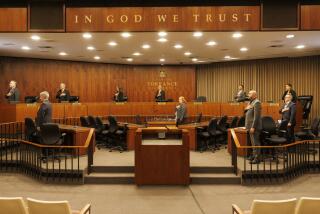Many small cities pay officials hefty health benefits
- Share via
Lake Forest and Laguna Hills, two Orange County bedroom communities that straddle Interstate 5 just south of the El Toro Y, look so similar that locals say you cannot tell when you’ve passed from one into the other.
With a population of 80,000, Lake Forest is twice the size of Laguna Hills. But when it comes to City Council perks, Laguna Hills leads its neighbor by a wide margin. Council members in Laguna Hills receive medical benefits worth an average of $24,300 a year— among the most generous in the state. Council members in Lake Forest, as well as nearby Laguna Woods and Laguna Beach, receive no medical benefits at all.
Medical benefits have come under increased scrutiny in several communities as cities have been forced to slash budgets and as the Bell salary scandal has reverberated around the state. In the last year, cities including Redlands, Hemet, Vernon and Thousand Oaks have reduced benefits or eliminated council medical benefits, though in many cases the new rules don’t apply to current council members.
A Times analysis of perks and benefits received by elected city officials across California found major disparities when it comes to medical coverage. The data show that some of the most generous benefits go to part-time council members in some of California’s smallest cities. For some of those officials, medical benefits significantly increase their total compensation. For example, Hawthorne’s mayor is paid $7,200 in salary, but his total compensation more than triples when healthcare is factored in.
Database: Healthcare benefits for all California city councils
Laguna Hills has emerged as a flashpoint in the debate. Medical benefits triple the total compensation of council members, who earn $7,400 in salary.
Mayor Allan Songstad Jr., a partner in an Irvine-based law firm, said he does not consider his medical benefits an extravagance.
“We are really not paid much and we spend a lot of time doing council work,” he said. “When I first started this benefit, it seemed a reasonable cost.”
Others in the city strongly disagree. Last year, activist Barbara Kogerman did her own detective work and learned that the health coverage provided to the council was the costliest in Orange County. One councilman’s medical, dental and vision plan cost the city $30,514 in a single year.
Kogerman’s investigation helped her win a spot on the City Council in November. She waived coverage because she is insured through her husband, a retired Marine Corps pilot.
The city pays premiums for Songstad, Melody Carruth, who is married to a lawyer, and Randal Bressette, a self-employed financial planner. Joel Lautenschleger, a retired healthcare business owner, was covered until this year, when he switched to Medicare, city records show. Songstad said he too will soon switch to Medicare.
Residents in Thousand Oaks protested this year after learning that the city was paying $111,000 a year in health benefits for active and retired council members. A 1997 resolution had given lifetime benefits to any council member who served at least five years and was at least 50. When the council’s salary is thrown in, the city was paying nearly a quarter-million dollars for its part-time elected leaders.
“The idea of healthcare for part-time public servants seems questionable,” said Jere Robings, a Thousand Oaks government watchdog who helped push the city to reduce medical benefits for future council members. “If this weren’t a government job, they would be considered independent contractors.”
The Times examined thousands of pages of records from 2009, the most recent year for which data are available. The analysis found that part-time council members in cities such as Industry, Vernon, Irwindale and Indian Wells, as well as Jackson in Gold Country and Sand City in Monterey County receive much more generous benefits than their full-time counterparts in cities like Los Angeles, San Francisco and San Diego.
The reasons for the disparity vary, though larger cities tend to come under more scrutiny for the perks of elected officials.
Providing medical benefits to council members, once considered unusual, is now the norm. The Times analysis found that more than two-thirds of the state’s 482 cities provide some coverage, mostly to part-time politicians who meet only a few times a month.
Some experts said the move to provide healthcare benefits occurred as city councils became less a bastion of white men, many of whom owned local businesses or were executives in local companies. With diversity came a need for better compensation to make public service possible, said David Mora, an analyst with the International City/County Management Assn.
“A health insurance benefit was something that would make it a bit more manageable for the incumbent, so that more people might be able to run for office,” Mora said. “It’s generally accepted practice.”
Scores of cities, however, do without it — and they appear not to have less diverse elected representation. It comes down to differing philosophies of public service, said Rick Cole, city manager of Ventura, which provides no health coverage for its seven council members.
“The council has always interpreted council service as flat salary,” Cole said. “They don’t get retirement and they don’t get health benefits.”
The Times analysis found a few cities that provide medical benefits not only for elected council members, but also for residents appointed to part-time commissions and panels.
The City of Industry, for instance, covers health benefits for its five-member council and 10 planning and redevelopment commissioners. In 2009, the cost of providing healthcare for all 15 part-timers was $364,815.
Mayor David Perez said he sees no problem with the arrangement, which has been in place since the city was incorporated in 1957. When he battled prostate cancer two years ago, he paid no medical bills.
“It’s a good plan,” said Perez, who turns 65 this year. “Our employees and the electeds, well, we are blessed, let’s put it that way.”
catherine.saillant@latimes.com
Times staff writer Doug Smith contributed to this report.
More to Read
Sign up for Essential California
The most important California stories and recommendations in your inbox every morning.
You may occasionally receive promotional content from the Los Angeles Times.











